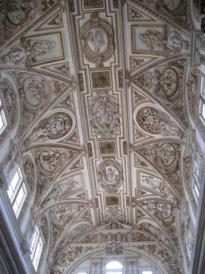Our third day in Spain included a stopover in Córdoba, where we saw that city’s main cultural treasure: the Great Mosque of Córdoba, a U.N. World Heritage site that’s been in existence in various forms since the year 600 CE. It’s switched from Christian to Islamic control and back again several times, following the ebb and flow of conquests of medieval Spain, and each time it changed hands it was rebuilt and expanded. In the process, it’s become a truly awe-inspiring example of religious architecture.
It began as a Christian church built by the Visigoths, but its most impressive phase began when it passed into the control of the Umayyad caliphate around 784. The tour guide said that, at a time when Madrid had a total population of less than 15,000, the mosque was built to hold 30,000 worshippers. But during the Reconquista, when the Catholic crusaders took back the city, they partially demolished and rebuilt one section to make a unique expansion of their own… but I’m getting ahead of myself.
To enter the mosque, we crossed a Roman bridge into the city proper and went through a gate in the exterior wall. Within was a courtyard filled with orange trees, dominated by a tower which has been both Muslim minaret and Christian belltower.
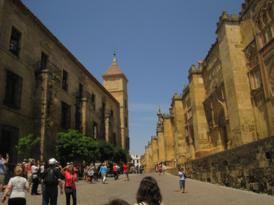 |
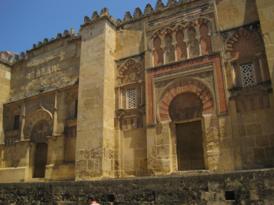 |
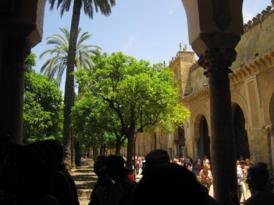 |
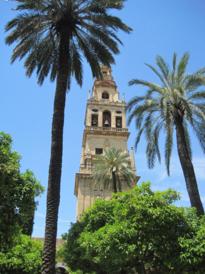 |
From the dusty, scorching heat and blazing sunlight outside, we stepped into a vast, dim, cool expanse of red-tiled floor, lit by lamps hanging from golden chains, where row upon row of marble columns rise into red-and-white-striped double arches to support the ceiling. The overall effect of the solemn, echo-filled, seemingly endless space was dreamlike and hauntingly beautiful, like a fantasy out of Borges as drawn by Dr. Seuss.
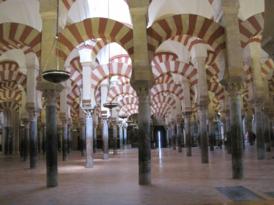 |
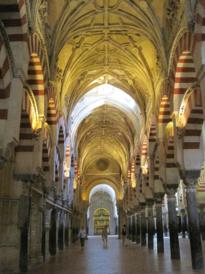 |
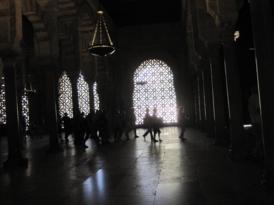 |
As you progress toward the center of the mosque, there’s a hallway partitioned by unusually large and massive pillars. Walk down the corridor, round the pillars, and you step into a sudden blaze of white and gold light:
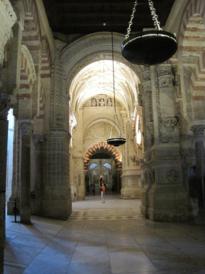 |
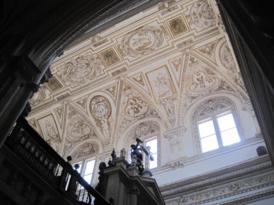 |
Walk into the light, and you find yourself in an enormous baroque cathedral hidden in the center of the mosque, as if a futuristic transporter had materialized one building within the other. Every surface was covered with art and sculpture, including this fantastically detailed ceiling:
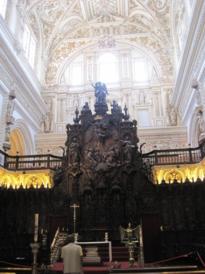 |
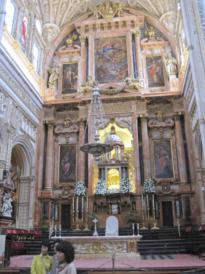 |
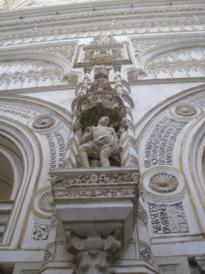 |
The overall effect could easily have been gaudy, but somehow it wasn’t. Despite their completely different aesthetics, the cathedral and the mosque somehow complement each other perfectly. The austere simplicity of one contrasts with the baroque intricacy of the other, as if to show the two extremes that religious devotion can take in the human mind.
A side room off the cathedral held this staggering golden sculpture. This is the monstrance, a vessel made to hold the consecrated bread used for the Eucharist – a breathtakingly lavish, but not atypical, example of the incredible wealth held by Spain’s churches. How much good could be done if vessels like this, used only for the exaltation of superstition, were melted down and used to fund efforts to alleviate real human need?
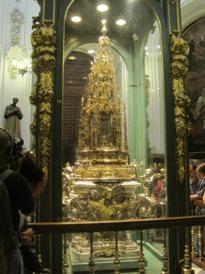 |
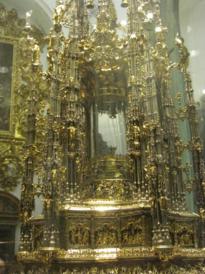 |
Walk through the cathedral, and you’re back into the cavernous, shadowy red cool of the mosque. At the far end we found the mihrab, the keyhole-shaped alcove that points the way to Mecca which every mosque has, surrounded by fantastically intricate Arabic calligraphy and geometric art:
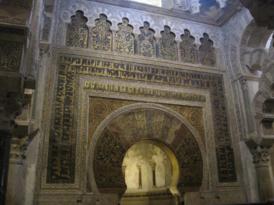 |
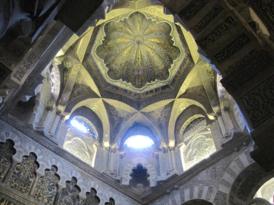 |
Several people in our tour group were brought to tears by the majesty and beauty of the place, and I didn’t blame them at all. That said, when I later looked up the Mosque of Cordoba online, I read something that significantly dimmed my admiration: The Catholic church, which still owns the entire property, flatly refuses to let Muslims pray there. Last year, there was an ugly incident in which a group of Muslim tourists tried to step away from their tour group to pray in the mosque section and were told by security guards that they had to either stop praying or leave, which resulted in a scuffle and several arrests.
The diocese’s official non-explanation is that allowing Islamic services “would not contribute to the peaceful coexistence of the two beliefs”. More likely, I think, is that the church greedily guards all its wealth and assets, including property, and doesn’t want to set any precedent that might later be used to argue they should share ownership with another group. It’s ironic that in a building like this one, which exemplifies the great beauty that human devotion and craftsmanship can create, the power of religion to divide human beings from each other and spur hatred and hostility is also on full display.
Next: The Cathedral of Seville and the tomb of Christopher Columbus.
